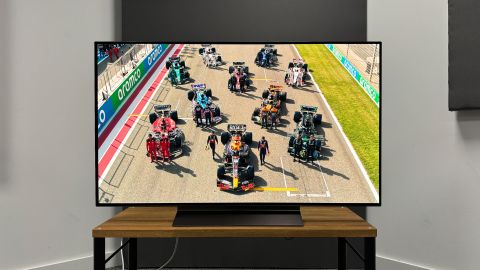Do not adjust your set, this isn’t the same LG C4 OLED TV review we’re sure you’ve already read, although the name and picture might look very similar. This is the smaller 48-inch version of the rather excellent LG C4 that we reviewed at 65 inches earlier this year and the sequel to the Award-winning LG OLED48C3 from last year.
You may be wondering why we’re reviewing this TV at a smaller size if we’ve already awarded the 65-inch version five stars, and we have a simple answer to that: performance can differ greatly at radically different sizes. While we’re confident that the 65-inch C4’s performance should also be indicative of the 55-inch and 77-inch models, the 48- and 42-inch versions differ greatly in key aspects, such as pixel density, brightness and sound systems.
LG’s C-series of step-down OLED TVs tend to be dependable performers for film enthusiasts and dedicated gamers alike in all sizes; although last year’s 65-inch C3 got off to a slightly rocky start thanks to an uncharacteristic four-star review. The 48-inch C3 was met with a warmer reception, but we still had some reservations regarding the higher price tag and minimal upgrade over its predecessor – although, we still considered it to be the best “small” TV on the market.
So, has LG struck gold yet again with this compact OLED TV? And more important, will this TV deliver all of the things we liked about the 65-inch version at a smaller size and more affordable price?
Price
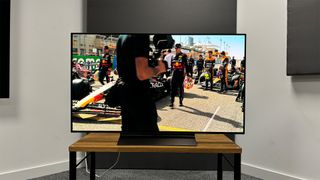
The 48-inch C4 launched at the exact same price as last year's 48-inch LG C3; £1499 / $1599 / AU$2499 (bear in mind the C3 launched at a higher price than the C2). It has been on sale for a little while now, which means price drops are already fairly common. We often see this TV down to around £1299 / $1200 in the UK and the US respectively, however, discounts seem less frequent Down Under.
Competition in this segment of the market has traditionally been thin, but this year it’s looking like LG has more rivals than ever before. Its first adversary is (surprisingly) its predecessor, as the 48-inch C3 is still on the market and has been deeply discounted since launch – at the time of writing it can be found for just £979 in the UK, although stock seems to be limited in most other regions. Furthermore, LG is also scaling down its entry-level OLED TV for 2024. The LG B4 now also comes in a 48-inch variant, although pricing and availability are still a mystery for this model in the UK.
Sony’s 48-inch A90K is also still alive and kicking after spending two years on the market, although it’s still more expensive than the C4 at £1599 / $1400 / AU$2290. Philips has also just launched the OLED809 in a 48-inch size, which is an alternative that is only available in the UK and EU. We haven’t reviewed the OLED809 at this size, but Ambilight fans can pick it up for a competitive £1299.
Finally, LG’s biggest rival and fellow Korean brand, Samsung, has launched its step-down OLED TV in a new 48-inch version too. The 48-inch Samsung S90D retails for £1349 / $1600 (it doesn’t appear to be available in Australia) which is cheaper than the C4 if we’re going off launch pricing – however, the LG’s current price undercuts this.
Build
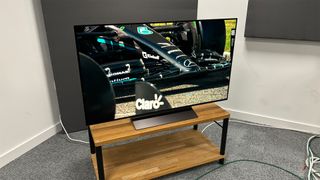
LG has stayed remarkably consistent with its design language in recent years. The C4 looks like the C3, which in turn looked like the C2; albeit the C4 features a darker, somewhat brushed bronze finish to its stand in comparison to the silver of the previous model. Speaking of the stand, it’s a centrally mounted pedestal style that is 48cm wide, which is very similar to the larger sizes in this range. It looks fairly sleek, if a little stale at this point, and it’s still not ideal for positioning a soundbar in front of it.

Screen size 48 inches (also available in 42in, 55in, 65in, 77in, 83in)
Type OLED
Backlight N/A
Resolution 4K
HDR formats HLG, HDR10, Dolby Vision
Operating system webOS 24
HDMI inputs x 4 (4 x 48Gbps HDMI 2.1)
Gaming features 4K/120Hz, VRR (up to 144Hz), ALLM, Dolby Vision game mode, HGiG
ARC/eARC eARC
Optical output? Yes
Dimensions (hwd, without stand) 62 x 107 x 4.7cm
Turning the C4 side on, we see that it retains the remarkably thin top section, with the guts of the system stored in a chunkier bottom section that takes up about two-thirds of the TV. There is a faux-stone effect on the top section of this TV that makes it look rather suave, however, we doubt you’ll spend much time staring at the back of this set if we’re being realistic.
There is one frustrating design quirk that we’re not so on-board with, and that’s the non-removable power cable. It’s not particularly long, and it's tricky to access, which raises durability concerns; put simply if the cable gets damaged, it's not an easy swap-out solution.
We’re also not huge fans of the included remote, which is the same handset we’ve seen on the prior two generations of this TV. The glossy plastic finish doesn’t feel premium and, while we appreciate that this isn’t a flagship TV, we’re getting tired of LG not offering backlit remotes with its premium OLED TVs. If Sony and Philips can do it, so can you, LG.
Features
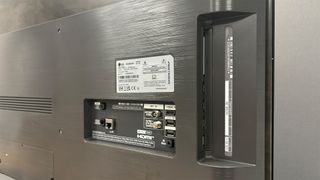
As this is a step-down model, this TV does not feature the Micro Lens Array (MLA) brightness-boosting technology of the flagship G4 OLED TV; however considering LG Display doesn’t manufacture MLA OLED panels in sizes smaller than 55-inches (yet), we’re not caught off guard or particularly disappointed. Instead, this is using one of LG’s OLED Evo displays, which is reportedly brighter than last year’s model – although LG doesn’t like to talk specific nit figures.
If there’s one thing we can depend on an LG C-series OLED TV to deliver upon, it’s gaming specs. It’s a nearly identical set-up to last year’s model with four HDMI 2.1 sockets with full 48Gbps bandwidth support for 4K/120Hz gaming with VRR and ALLM supported. New for this 2024 model is 144Hz VRR support, which won’t mean much to console gamers (at least right now), but PC gamers with capable rigs can hook their towers up for even silkier high refresh-rate gaming. There is also Dolby Vision Gaming and HGiG support for HDR gaming on supported sources and titles.
On the subject of HDR, the C4 supports HDR10, Dolby Vision and HLG. HDR10+ isn’t supported, but that has been the case with LG TVs for quite some time so it is no surprise. It’s not much of a disappointment, either, as it’s very easy to live without HDR10+.
The C4 also supports Dolby Atmos audio when connected to a compatible soundbar or AVR over HDMI eARC. If you pair this TV with an LG soundbar, you can also take advantage of WOW Orchestra, which combines the TV’s 2.2-channel audio system with the soundbar audio.
The C4 also uses LG’s webOS 24 smart platform, which has a handful of positive and negative aspects. App support is impressive, with a strong selection of global and localised streaming apps that all work as expected, and some will find the Magic Remote pointer interface (that will be familiar to anyone who had a Nintendo Wii) to be a fairly slick way of operating the TV. That being said, the current version of webOS, like the last version, is rather advertisement-heavy; with a large sponsored content bar at the top of the page and even shopping suggestions taking up precious content rails on the home screen.
Finally, we have the Alpha 9 Gen 7 processor powering this TV and it’s worth noting that this is a less powerful processor than the flagship LG G4’s Alpha 11 chip. While that might seem like an obvious feature – this is a step-down model after all – it’s worth noting that prior generation C-series OLED TVs shared the same processor with their flagship counterparts. That ends with the C4 series by the looks of things, as it instead features a slightly upgraded version of last year’s processor; although it does receive a spattering of new features over the C3, such as virtual 11.1.2 sound upmixing and an enhanced voice remastering feature.
Picture
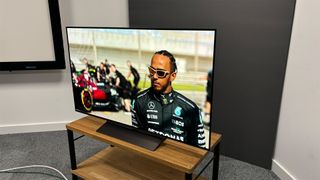
We found the 65-inch version of this TV to be a formidable step up in picture quality over its predecessor, and a worthy adversary to our current Award-winner, the Sony A80L. While there are plenty of factors to consider when scaling down a five-star TV from 65 to 48 inches, we honestly find that many of the attributes we admire from the larger TV have worked their way down to the more compact model.
We are once again comparing the C4 to the 55-inch Sony A80L, and we have our trusty reference 4K Blu-ray discs to hand (Blade Runner 2049, Top Gun: Maverick and Oppenheimer) as well as Mad Max: Fury Road on Apple TV to test the Dolby Vision capabilities. While there is a discrepancy in screen size, we’ve taken that into account for our testing when considering the greater pixel density of the smaller LG set and the higher brightness capabilities of the larger Sony TV.
Diving into the LG’s picture in our preferred picture setting of Filmmaker mode with the Cinematic Movement clarity setting applied, we find that the smaller C4 has all of the richness and solidity of the larger variant. Colours appear warm – especially side by side with the cooler-toned Sony – and skin tones have a touch more life to them, making the A80L look a tad pasty in comparison.
Generally speaking, colours are pleasingly punchy without looking garish; in fact, it's with this TV that we find out that the car driven by Oppenheimer as he moves his family to the Los Alamos facility is a deep shade of forest green, not black. A later shot of a watch tower in the New Mexico desert is pleasingly crisp and three-dimensional without looking overly etched. Three-dimensional depth is, arguably, the Sony’s greatest strength, so seeing the LG go toe-to-toe with the Award winner is an impressive sight indeed.
LG hinted that the smaller C4s had a noticeable upgrade in brightness, and while we don’t have a C3 on hand for a side-by-side, we have to say that the OLED48C4 handles highlights very well indeed. A glimpse of the sun through some foliage in Oppenheimer immediately draws our eye thanks to its punchy and vibrant presentation, while also remaining controlled and natural.
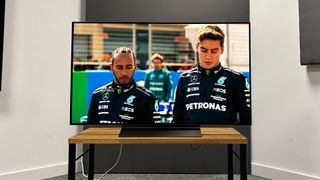
A new picture feature for 2024 is the Dolby Vision Filmmaker Mode, which we take for a spin with Mad Max: Fury Road. The C4 delivers this film with equal parts punch and composure, with the rich reds and yellows of the smoke flares contrasting beautifully with the natural cool blue of the sky and burnt golden sand. This TV is also meticulously detailed. The various scratches and metal rivets of the War Rig are displayed with excellent levels of detail, and the same can be said with skin and clothing textures too.
We also find the Cinematic Movement setting to be useful when watching something like Mad Max as the frantic action is handled well, with no noticeable judder or stuttering. We could accuse it of being ever-so-slightly heavy handed with smoothing out motion occasionally, but we decide that its a worthwhile tradeoff for better motion handling overall.
If we had to complain about something, it would be that the C4 can feel slightly restrained in the Dolby Vision Filmmaker mode. While we find this to be the best mode overall for authenticity, accuracy and realism; we can’t help feeling that it makes the picture look somewhat dim at times – however we wouldn’t consider this to be a deal breaker, and the other picture modes seem to overcompensate with too much artificial-feeling brightness.
Using non-4K and SDR content, we find that the TV does an admirable job of freshening up content with a crisp and balanced picture that doesn’t look overly processed or artificially sharpened.
Sound
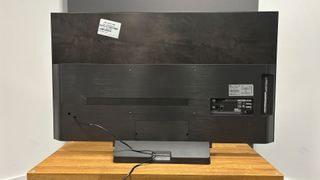
While the larger C4 got kudos for its improved sound system, the smaller model unfortunately doesn’t get the same treatment.
Using our trusty Blade Runner 2049 chapter two reference sequence, we find that the TV immediately struggles with the admittedly tricky low-end effects. There is notably distortion at the deepest frequencies which remains persistent even when we reduce the volume, and the thumping bassline featured in this scene just doesn’t have enough depth or impact. It’s also quite a localised sound, with fairly uninspiring projection or scale. The sound sticks close to the chassis of the TV, with the downfiring speakers offering little in the way of directional sound.
The LG wins some points back when we reach dialogue heavy scenes such as the baseline interview. Vocals are clear and there is a semblance of emotion carried within the characters voices. Furthermore, it’s not terrible at larger displays of dynamics, with sudden explosions in Oppenheimer being delivered with a fairly responsive punch – although our criticism regarding the lack of low end weight still stands.
For best results we’d still recommend pairing this TV with a Dolby Atmos soundbar – ideally a compact option to match the footprint of this TV such as the Sonos Beam (Gen 2).
Verdict
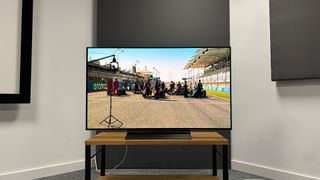
Stop us if you’ve heard this one before, but LG’s latest C-series OLED TV is the best 48-inch TV you can buy right now. It undercuts or matches its rivals where price is concerned, it has a flawless feature set for gamers, and its picture is a clear step up over its predecessor.
While we wish LG would go back to the drawing board for built-in sound, and maybe cut back on ads in the user interface, we find very little else to criticise this TV on, making it an easy recommendation for those who want a truly cinematic experience without sacrificing loads of space.
First reviewed: August 2024. Updated review: November 2024.
SCORES
- Picture 5
- Sound 3
- Features 5
MORE:
Read our review of the Sony XR-48A90K
Also consider the LG OLED48C3
Read our LG OLED65C4
